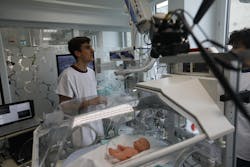Camera system optically monitors premature babies without skin contact
A team of researchers from the École Polytechnique Fédérale de Lausanne (EPFL; Lausanne, Switzerland) and the Centre Suisse d'Electronique et de Microtechnique (CSEM; Neuchâtel, Switzerland) have developed a contactless and wireless camera system to continuously monitor the vital signs of premature babies (preemies) in neonatal incubators, with the goal of replacing on-skin sensors that can cause false alarms nearly 90% of the time.
Related: NIR light technique is promising for premature baby lung examination
The camera system, which will be tested on preemies at project partner University Hospital Zurich as a proof-of-concept, was developed to improve the way babies' heart rates and breathing are monitored. "Skin sensors placed on the babies' chests are so sensitive that they generate false alarms up to 90% of the time, mainly caused by the babies moving around," says Jean-Claude Fauchère, a doctor at University Hospital Zurich (USZ)'s neonatal clinic. "This is a source of discomfort for the babies because we have to check on them every time. It's also a significant stress factor for nurses and a poor use of their time—it distracts them from managing real emergencies and can affect quality of care."
With the camera system, no physical contact is required. The baby's pulse is detected by analyzing its skin color, which changes ever so slightly every time its heart beats. Breathing is monitored by measuring movements of its thorax and shoulders. At night, infrared (IR) cameras take over, which means that monitoring can be carried out nonstop.
The optical system was designed by the CSEM researchers, who chose cameras that are sensitive enough to detect minute changes in skin color. They teamed up with researchers from EPFL to design algorithms used to process the data in real time. CSEM focused on respiration, while EPFL worked on the heart rate.
"We ran an initial study on a group of adults, where we looked at a defined patch of skin on their foreheads," says Sibylle Fallet, a PhD student at EPFL. "With our algorithms, we can track this area when the person moves, isolate the skin pixels, and use minor changes in their color to determine the pulse. The tests showed that the cameras produced practically the same results as conventional sensors."
Virginie Moser, the CSEM researcher in charge of the setup at USZ, says that they plan to take measurements on as many preemies as possible to see whether, under real-life conditions, the results they get from their algorithms match data collected using on-skin sensors.
For more information, please visit www.nano-tera.ch.
